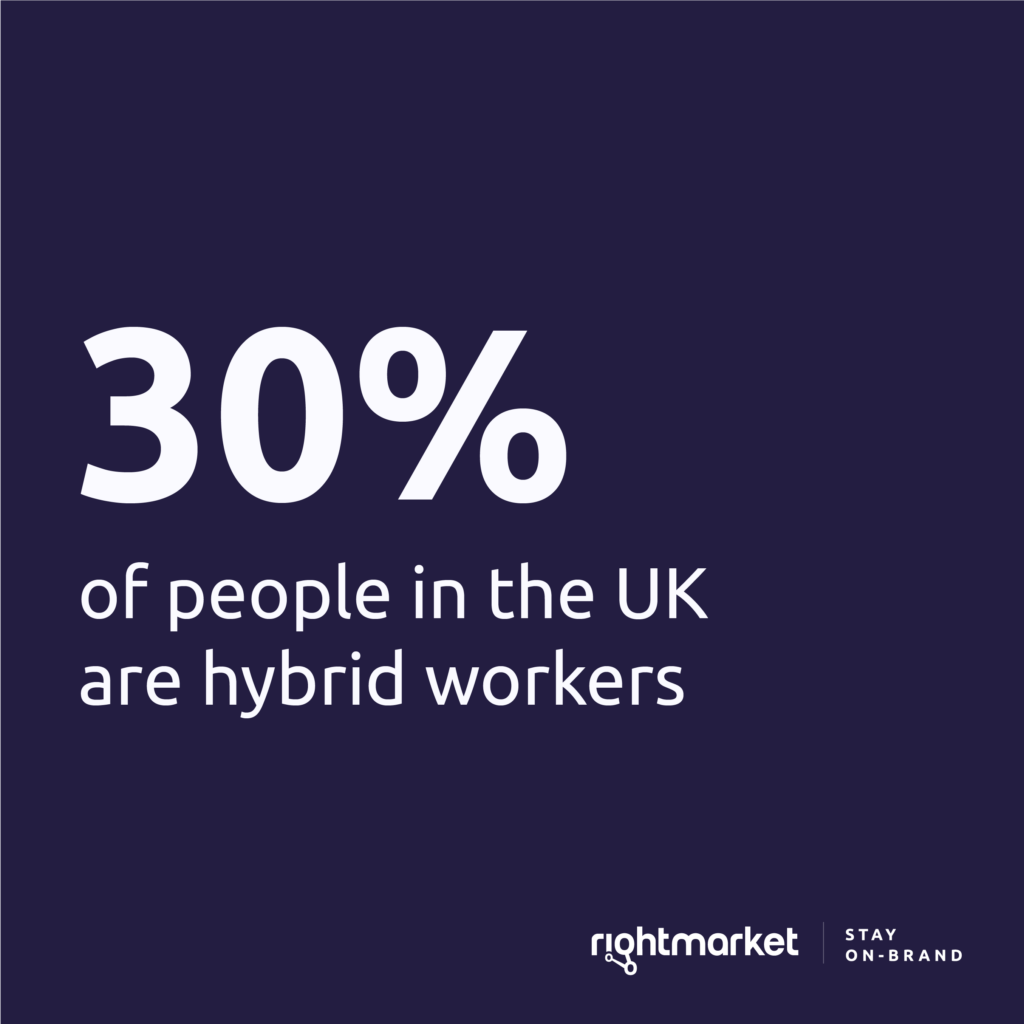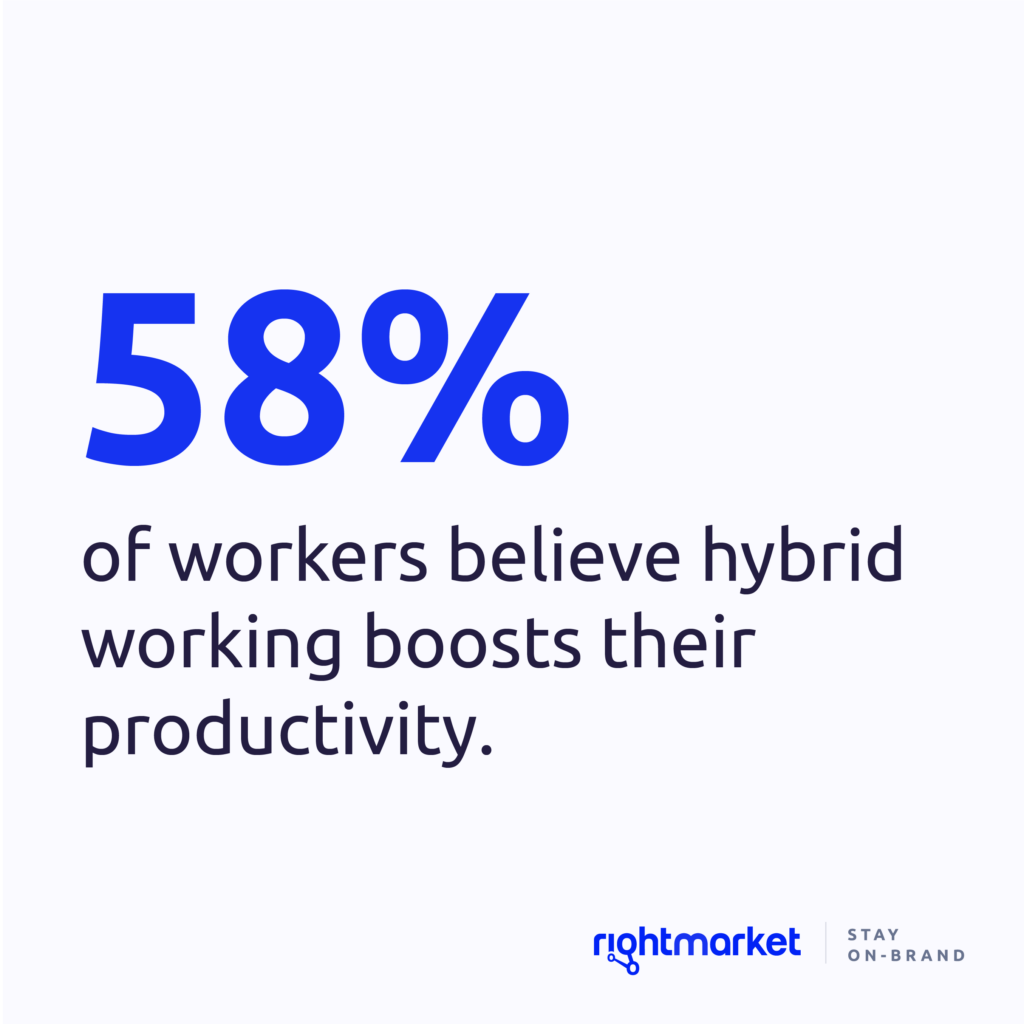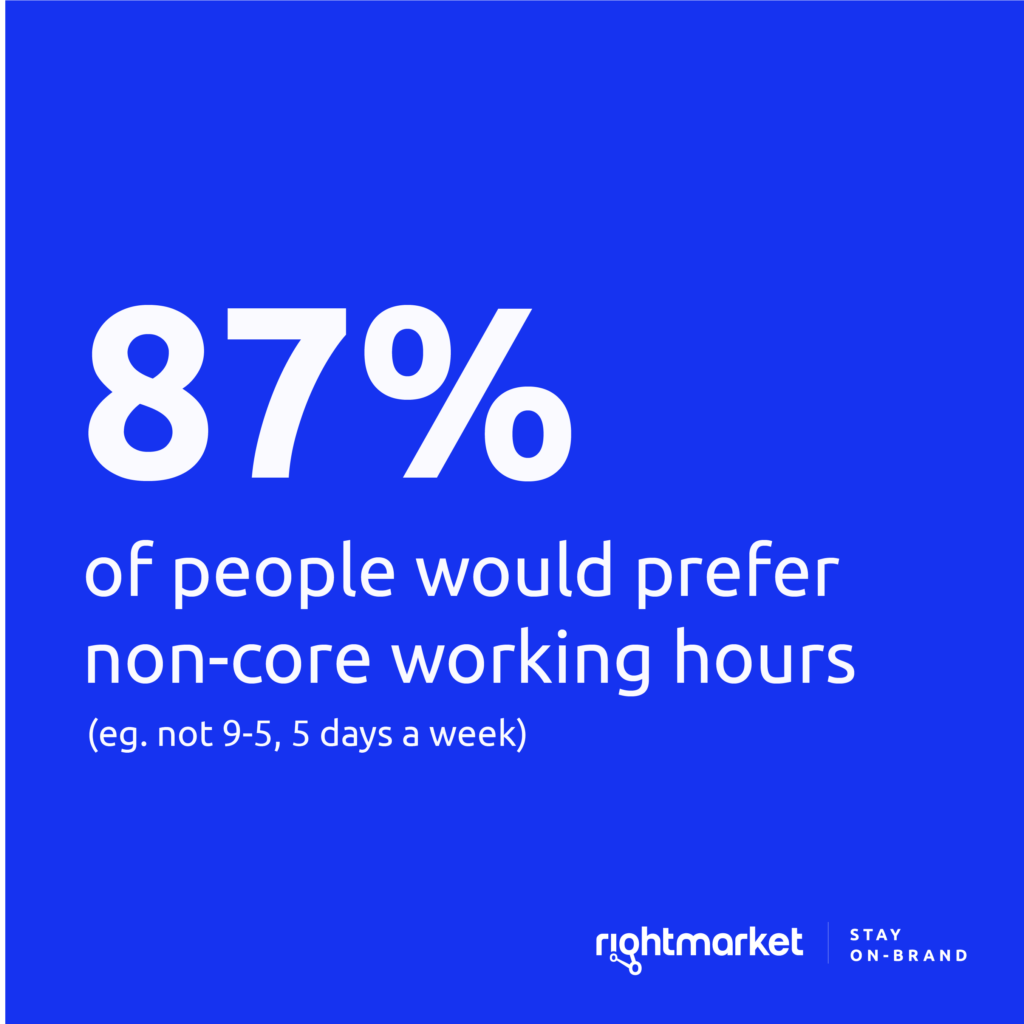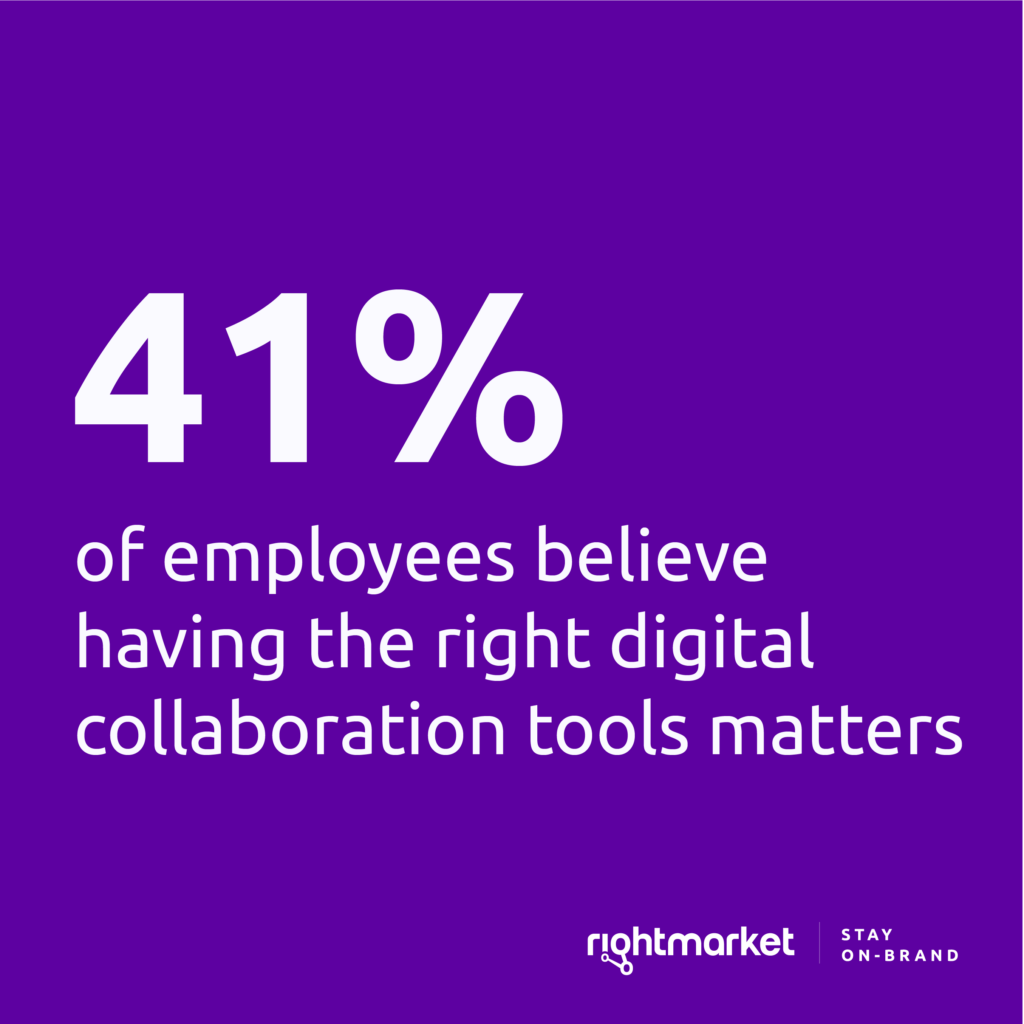
Working life is now hybrid: are your brand management processes right?
After the coronavirus pandemic, there were very few things people wanted to stick around. Something that has remained, however, is hybrid working.
As of November 2022, 30% of full-time UK employees have a hybrid working schedule. That’s not to mention the number of people who work completely remotely.
Since the pandemic, RightMarket has been a
virtual office rather than a physical one. So, we know first-hand the
benefits.
By opting for a hybrid approach, employees can enjoy a
better work/life balance and increased flexibility. Organisations get access to
a wider pool of talent that isn’t restricted by location.

Yet, there are challenges associated with hybrid working. One of the common casualties is your brand management.
Everyone has a part to play in protecting brand. If they aren’t aligned, working apart often exposes inconsistencies. It becomes harder to rectify too.
We explore the brand challenges presented by hybrid working and how to navigate them for better protection.
- The impact of hybrid working on brand
- How to manage your brand in the hybrid environment
- How RightMarket helps
The impact of hybrid working on brand
There’s no denying that hybrid working that brings many benefits. 58% of employees believe their productivity increases in a hybrid environment. 87% of people prefer non-core working hours – which hybrid enables them to do.
If you have the right brand processes in place, it’s arguable that you could get better results from your people. But it means understanding their needs and the challenges presented.

Trying to keep people on brand is like herding cats at the best of time. Add in different locations and working hours and it becomes harder.
Here are the common obstacles you may experience when trying to manage and market your brand in these circumstances:
Monitoring output
In a typical office environment, you have good visibility of what other people are working on. If someone is working on marketing materials or brand assets, they just need to stop by your desk to ask for feedback. Equally, you’re likely having regular conversations about your brand and how it should be used.
In a hybrid world, those conversations happen less often. People could create materials themselves, using insufficient tools. And you wouldn’t even know.
It also becomes much harder to detect errors until it’s too late. If off-brand communications slip through the net, your consistency and reputation is damaged. Not to mention confused customers.
Education
Good brand governance should educate people, not just correct them. You need to share practical advice that gives people the knowledge they need to stay on-brand. A significant part of this is sharing your brand guidelines.
In the past, this might have been easy to communicate through simple conversations and physical documents. If your teams are working apart, you need to find new ways to do this. Most crucially, you need to reach people wherever they are – which means digital processes.
Enabling agile marketing
One of the perks of remote working is that people can work whenever suits them. From four-day weeks to late night productivity, the typical 9-5 is no longer the only option.
But, it also means people may work different hours which can cause production bottlenecks.

Let’s say team A handles all your brand creative and artwork. Someone from team B needs a poster to pin up on a community notice board and puts a request in at 4pm on a Thursday. But team A don’t work Fridays. That’s a whole extra day until that poster can be created, which gives you less time to embrace the opportunity.
In a bid to speed things up, team B might do the poster themselves. This leads to off-brand marketing.
It’s also worth noting that external partners may no longer work a 9-5, meaning marketing opportunities appear at any time. You need to find ways to embrace them in a timely manner.
Working through design requests
In the remote way of working, people can no longer just pop by to ask a favour. There needs to be a formalised processes to manage requests.
There are two potential fallouts from this. First, you’ll see just how much work is coming marketing’s way. Working through these can take time, which causes delays and overburdens marketing.
Secondly, it might put people off requesting altogether. They might not want to hassle other people or wait for a response, so do it themselves instead. These leaves to liable to brand inconsistencies.
Giving people the right tools
41% of employees believe having a digital collaboration platform is important when working apart. This includes having the right tools to protect and enhance brand.
To enable people to be productive and keep them on-brand, you need to find a solution that empowers them. It also must bring them together, even when they’re apart. Without it, you risk them using alternative options – like Canva and WordArt – that don’t control the brand.

How to manage your brand in the hybrid environment
So, you know the challenges of managing your brand when the people using it are hybrid working. But what can you do to keep people on-brand, regardless of where and when they’re working?
We’ve got some tips to help you out.
1. Have clear, formal brand processes
The first step to keeping everyone aligned is giving them set processes to follow. These should outline who is responsible for the creation and approval of your brand materials.
If you have teams who will be creating all marketing or brand assets, the process should dictate how requests are made. Incorporate things like which information should be included in the brief, where they should be sent to and how much notice to give. You may also communicate turnaround times to set expectations. In a hybrid environment, briefs will need to be submitted digitally.
If you allow people to create their own assets, you’ll want to cover off things like which tools to use and what to do. This might also tie into your brand guidelines – which we’ll discuss in more detail shortly.
Include sign-off steps they need to follow, including who to share their work with for feedback. It could include marketing, creative or even their department lead.
Think carefully about who provides approval. They will essentially be the gatekeeper of the brand and need to ensure it is being used consistently.
While having set processes is a great foundation, you also need to monitor them. If they’re not working, you need to consider alternative solutions.
2. Lead the way
The biggest challenge when trying to keep people on-brand is ensuring they know what ‘on-brand’ means. They might know what your logo looks like, but they don’t necessarily know how it should be positioned in a document.
The best way to overcome is to show rather than tell. Leading by example will highlight how your brand should be use, making it easier for them to replicate.
Make sure key players – such as marketing and leadership – are being consistent and accurate in everything they create. Emails, letters, presentations and so on should embody your brand guidelines perfectly.
Over time, this will understand your brand identity better and use it correctly in their work.
3. Digitalise your brand guidelines
In today’s world, having brand guidelines sat in a drawer is no good. People need to have access wherever they are. If you haven’t already, it’s time to digitalise.
Brand guidelines set out your brand so people can adhere to them. Elements like logo style, colours, fonts and tone of voice should be laid out.
However, even with those in place, you can’t guarantee people stick to them. If you’re digitalising your brand guidelines anyway, it’s worth progressing to brand templates.
Brand templates are pre-designed documents that include your visual elements already. All anybody would need to change is the text in the template and possibly some imagery. Then they have an on-brand design to share, without having to memorise your guidelines.
Whether you choose templates or guidelines, make sure the right people have access. It means there’s no room for inconsistency or production bottlenecks.
4. Invest in tools
Digital platforms are crucial for teams working collaboratively in remote environments. It’s no different when it comes to brand management.
Investing in a brand management tool is an ideal solution. Most will utilise brand templates, meaning the need for complicated guidelines is eliminated. Your organisation’s users are empowered to create on-brand materials.
Remember to find a tool that works even for remote users. This will make it easy for people to access it on their terms, giving them 24/7 support.
It’ll also streamline your processes. Marketing save time from having to process every request. There’s also no need for time-consuming approval processes.
How RightMarket helps
RightMarket is the brand management solution that keeps everyone on-brand. We create templates that embody your brand guidelines. With the power to create brand materials, they can embrace local marketing opportunities and do their part to extend your reach.
We also provide remote log-in and 24/7 access, meaning users can create when and where suits them.
Admin users, such as your marketing and creative team, have access to usage data to monitor output and analyse performance. There’s also the option of approval workflows, meaning brand designs can be reviewed even from afar.
Book a demo today
To find how RightMarket can make it easy to manage your brand, even when your teams are in different locations.